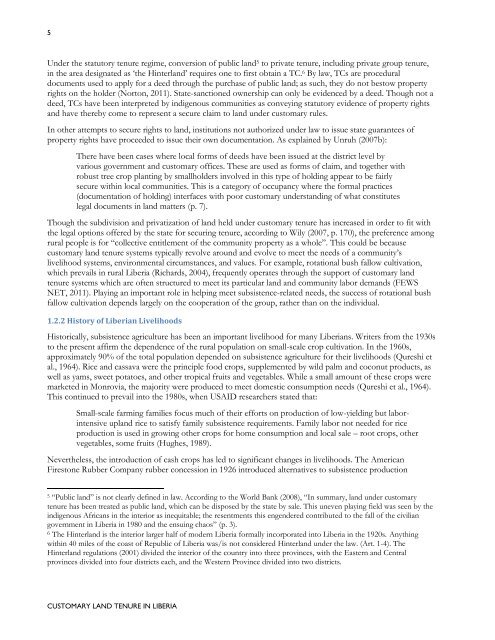Customary Land Tenure in Liberia - Land Tenure and Property ...
Customary Land Tenure in Liberia - Land Tenure and Property ...
Customary Land Tenure in Liberia - Land Tenure and Property ...
You also want an ePaper? Increase the reach of your titles
YUMPU automatically turns print PDFs into web optimized ePapers that Google loves.
5<br />
Under the statutory tenure regime, conversion of public l<strong>and</strong> 5 to private tenure, <strong>in</strong>clud<strong>in</strong>g private group tenure,<br />
<strong>in</strong> the area designated as „the H<strong>in</strong>terl<strong>and</strong>‟ requires one to first obta<strong>in</strong> a TC. 6 By law, TCs are procedural<br />
documents used to apply for a deed through the purchase of public l<strong>and</strong>; as such, they do not bestow property<br />
rights on the holder (Norton, 2011). State-sanctioned ownership can only be evidenced by a deed. Though not a<br />
deed, TCs have been <strong>in</strong>terpreted by <strong>in</strong>digenous communities as convey<strong>in</strong>g statutory evidence of property rights<br />
<strong>and</strong> have thereby come to represent a secure claim to l<strong>and</strong> under customary rules.<br />
In other attempts to secure rights to l<strong>and</strong>, <strong>in</strong>stitutions not authorized under law to issue state guarantees of<br />
property rights have proceeded to issue their own documentation. As expla<strong>in</strong>ed by Unruh (2007b):<br />
There have been cases where local forms of deeds have been issued at the district level by<br />
various government <strong>and</strong> customary offices. These are used as forms of claim, <strong>and</strong> together with<br />
robust tree crop plant<strong>in</strong>g by smallholders <strong>in</strong>volved <strong>in</strong> this type of hold<strong>in</strong>g appear to be fairly<br />
secure with<strong>in</strong> local communities. This is a category of occupancy where the formal practices<br />
(documentation of hold<strong>in</strong>g) <strong>in</strong>terfaces with poor customary underst<strong>and</strong><strong>in</strong>g of what constitutes<br />
legal documents <strong>in</strong> l<strong>and</strong> matters (p. 7).<br />
Though the subdivision <strong>and</strong> privatization of l<strong>and</strong> held under customary tenure has <strong>in</strong>creased <strong>in</strong> order to fit with<br />
the legal options offered by the state for secur<strong>in</strong>g tenure, accord<strong>in</strong>g to Wily (2007, p. 170), the preference among<br />
rural people is for “collective entitlement of the community property as a whole”. This could be because<br />
customary l<strong>and</strong> tenure systems typically revolve around <strong>and</strong> evolve to meet the needs of a community‟s<br />
livelihood systems, environmental circumstances, <strong>and</strong> values. For example, rotational bush fallow cultivation,<br />
which prevails <strong>in</strong> rural <strong>Liberia</strong> (Richards, 2004), frequently operates through the support of customary l<strong>and</strong><br />
tenure systems which are often structured to meet its particular l<strong>and</strong> <strong>and</strong> community labor dem<strong>and</strong>s (FEWS<br />
NET, 2011). Play<strong>in</strong>g an important role <strong>in</strong> help<strong>in</strong>g meet subsistence-related needs, the success of rotational bush<br />
fallow cultivation depends largely on the cooperation of the group, rather than on the <strong>in</strong>dividual.<br />
1.2.2 History of <strong>Liberia</strong>n Livelihoods<br />
Historically, subsistence agriculture has been an important livelihood for many <strong>Liberia</strong>ns. Writers from the 1930s<br />
to the present affirm the dependence of the rural population on small-scale crop cultivation. In the 1960s,<br />
approximately 90% of the total population depended on subsistence agriculture for their livelihoods (Qureshi et<br />
al., 1964). Rice <strong>and</strong> cassava were the pr<strong>in</strong>ciple food crops, supplemented by wild palm <strong>and</strong> coconut products, as<br />
well as yams, sweet potatoes, <strong>and</strong> other tropical fruits <strong>and</strong> vegetables. While a small amount of these crops were<br />
marketed <strong>in</strong> Monrovia, the majority were produced to meet domestic consumption needs (Qureshi et al., 1964).<br />
This cont<strong>in</strong>ued to prevail <strong>in</strong>to the 1980s, when USAID researchers stated that:<br />
Small-scale farm<strong>in</strong>g families focus much of their efforts on production of low-yield<strong>in</strong>g but labor<strong>in</strong>tensive<br />
upl<strong>and</strong> rice to satisfy family subsistence requirements. Family labor not needed for rice<br />
production is used <strong>in</strong> grow<strong>in</strong>g other crops for home consumption <strong>and</strong> local sale – root crops, other<br />
vegetables, some fruits (Hughes, 1989).<br />
Nevertheless, the <strong>in</strong>troduction of cash crops has led to significant changes <strong>in</strong> livelihoods. The American<br />
Firestone Rubber Company rubber concession <strong>in</strong> 1926 <strong>in</strong>troduced alternatives to subsistence production<br />
5 “Public l<strong>and</strong>” is not clearly def<strong>in</strong>ed <strong>in</strong> law. Accord<strong>in</strong>g to the World Bank (2008), “In summary, l<strong>and</strong> under customary<br />
tenure has been treated as public l<strong>and</strong>, which can be disposed by the state by sale. This uneven play<strong>in</strong>g field was seen by the<br />
<strong>in</strong>digenous Africans <strong>in</strong> the <strong>in</strong>terior as <strong>in</strong>equitable; the resentments this engendered contributed to the fall of the civilian<br />
government <strong>in</strong> <strong>Liberia</strong> <strong>in</strong> 1980 <strong>and</strong> the ensu<strong>in</strong>g chaos” (p. 3).<br />
6 The H<strong>in</strong>terl<strong>and</strong> is the <strong>in</strong>terior larger half of modern <strong>Liberia</strong> formally <strong>in</strong>corporated <strong>in</strong>to <strong>Liberia</strong> <strong>in</strong> the 1920s. Anyth<strong>in</strong>g<br />
with<strong>in</strong> 40 miles of the coast of Republic of <strong>Liberia</strong> was/is not considered H<strong>in</strong>terl<strong>and</strong> under the law. (Art. 1-4). The<br />
H<strong>in</strong>terl<strong>and</strong> regulations (2001) divided the <strong>in</strong>terior of the country <strong>in</strong>to three prov<strong>in</strong>ces, with the Eastern <strong>and</strong> Central<br />
prov<strong>in</strong>ces divided <strong>in</strong>to four districts each, <strong>and</strong> the Western Prov<strong>in</strong>ce divided <strong>in</strong>to two districts.<br />
CUSTOMARY LAND TENURE IN LIBERIA

















